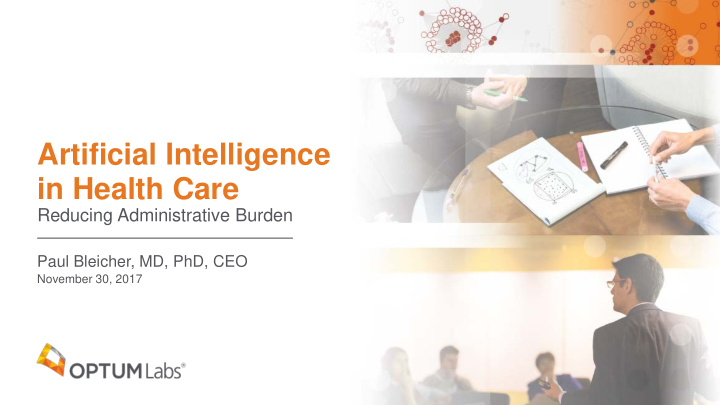



Artificial Intelligence in Health Care Reducing Administrative Burden Paul Bleicher, MD, PhD, CEO November 30, 2017
Types of Machine Learning and AI A range of solutions developed over decades fuzzy boundaries Rules-based Statistical Machine Artificial Decision Making Reasoning Learning Intelligence input if condition fulfilled ? set of methods y then activity 1 complex behavior activity 2 simple regression classification tasks dynamic adaptation to novelty Boolean Data Numerical Data Arbitrary Data Arbitrary Data (yes or no) allowing for curve fitting that needs to be abstracted autonomous selection of best into numbers methodology when presented Health care examples: with arbitrary data Health care examples: • Grouping claims into episodes • Estimating costs to serve Health care examples: of care Health care examples: a population • Identifying patients at risk • Recommend ”best fit” provider for readmission • Identifying gaps in care • Predicting medical spending for a member for members • Identifying patients who are at risk • Identifying fraud • Making diagnosis from patient for using the ED inappropriately symptoms, physical exam and • Determining prior authorization laboratory values for medications Image Credit: Dr. Boris Adryan 2
Deep Learning A type of Machine Learning transforming AI today Deep Learning Neural Networks (DLNNs) are enabled by: • Massive amounts of labeled data • Hardware advances (GPUs for gaming) • Image and text data Deep Learning is driving most of the recent breakthroughs in AI in other industries: • Face recognition • Self-driving cars • Language translation (Google) • Credit card fraud detection (FICO Falcon) • Terrorism flight risk 3
Deep Learning in Health Care Recent publications indicate promising opportunity Researchers have successfully reused trained neural networks Benign • A Deep Learning Neural Network (DLNN) trained to recognize cats and dogs can be repurposed to distinguish pathology in medical images Malignant Recent work has shown promising results in image classification: Kalouche S. Vision-Based Classification of Skin Cancer Using Deep Learning. Stanford University. • Skin lesions • Pathology images • Retinal hemorrhage Figure 1. Our trained convolutional neural network correctly • Signal processing – EEG, ECG data detecting the sinus rhythm (SINUS) and Atrial Fibrillation (AFIB) But work continues to make results more from this ECG recorded with a single-lead wearable heart monitor interpretable • Classifiers today are best suited to scan data for Rajpurkar P, Hannun A, et al. Cardiologist-Level Arrhythmia skilled professionals Detection with Convolutional Neural Networks , arXiv:1707.01836v1 [cs.CV] 6 Jul 2017. 4
Administrative Processes Well-suited for Deep Learning Many administrative processes for claims KEY INGREDIENTS OF ADMINISTRATIVE WORKFLOWS rely on analyzing text data • Charts • Notes • Comments Set steps in a process Often, sequences of events are critical to determine an outcome • Groups of claims Decisions recorded Large amounts of • A progression of care in workflow systems unstructured text data The results of these decisions are well-suited Complex manual review process to train a neural network TYPES OF DATA MANUAL PROCESS DECISIONS 5
Deep Learning The model is not the solution Assess Gather data and Implement Problem, available implement model Solution data, and solution Regularly measure benefit Train Refine Infer Measure Modify Solution/Model 6
Applying Deep Learning Neural Networks(DLNNs) Use cases underway Problem Model Solution Measure/adjust Use labeled ED visits and EHR Proactively reach out to priority Audit/monitor outcomes of Avoidable ED visits data /claims data to predict patients to educate them about patients contacted to identify patients at risk for these visits alternative care options appropriate ED visits Change claims review process • Audit/monitor Use labeled claims data to Unnecessary medical to include automated approvals false positives predict claims that should be claim reviews and review claims flagged for automatically paid • Evaluate policy change review Use historical prior Change prior authorization • Audit/monitor false positives authorization data to predict process to include automated Untimely prior authorizations which requests should be approvals and requests • Evaluate policy change automatically approved requiring review 7
Recommend
More recommend